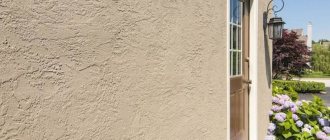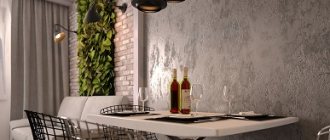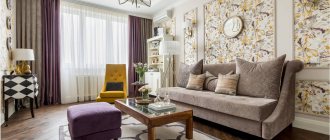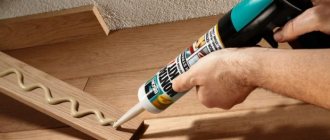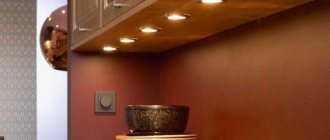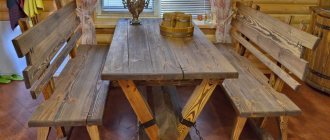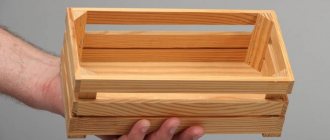Home » Decor » Wall decoration
DesignWall decoration
Novozhenina Anna
Venetian plaster in the interior will last for a long century, becoming more beautiful and durable over time. You'll love the variety of effects it can do. Find out about the various options for using it in more detail later in the article.
Features of the material
Venetian plaster (also known as polished) is a wall covering that imitates a variety of fine surfaces - from polished marble to natural stone effects - for a luxurious decorative design. Its application was a labor-intensive process requiring patience and skill, so the work was largely limited to craftsmen.
Today, even a beginner in the DIY industry can create impressive results. The finish imitates the appearance of plaster or polished marble, characteristic of old world European architecture. The modern version of Venetian plaster has a multi-dimensional appearance with a textured, slightly raised surface that is the result of two or more layers.
Venetian plaster is a wall covering that imitates various noble surfaces
This interior decoration gained popularity in the 1550s in Venice, hence the name. It involves several layers of plaster applied with a trowel to create a three-dimensional effect. The final coat is sanded down to create a shiny finish.
Types of wax
The work of applying this material is very painstaking and requires a lot of attention from the master, because the layer of wax must be very thin. It should be some kind of film that merges with the structure of the material.
Today, the construction market offers a large number of similar coatings, which differ from each other in a variety of ways. In this case, from all types of wax the following groups can be distinguished:
- Gel wax. Its inherent type of consistency is excellent for a hard and dense plaster layer.
- Liquid solution. It will be good for porous surfaces, which it will perfectly cover with a protective thin layer.
- A natural composition of wax for Venetian plaster, the main component of which is a beekeeping product. Such mixtures are made based on water. Their recipe includes only natural ingredients. After applying natural wax to the surface, it becomes glossy. This is quite important for some types of structures.
- Synthetic option. This wax contains polymer compounds. In this regard, the protective layer of Venetian plaster is as resistant to damage as possible. This coating will allow the material to last for a long time. After applying the synthetic version of the protective layer, the surface of the plaster becomes matte.
- Transparent wax. This coating option is most often used for Venetian plaster.
Many masters have their own secrets of not only using, but also making wax for Venetian plaster. Thus, Antonov’s wax is widely known. This is a specialist in Venetian plaster from Kyiv, who is also the author of numerous courses.
Facts about plaster that you didn't know
Polished plaster is a versatile, elegant decorative wall finish used since the 1st century BC in traditional Italian architecture. Known for its durability and beautiful finish, the method creates a stunning decorative effect that inspires, motivates and adds value to any building.
Versatile, elegant decorative wall decoration
Venetian is a special type of polished plaster mixed with marble dust, quartz or kaolin and applied with a spatula to the walls in a special way. It is painted to give the surface a wide range of colors. Depending on the method of application, there are methods called:
- marmorino (marmorino);
- scagliola (scagliola);
- sgraffito (sgraffito).
It is applied in thin layers, which are then polished to create a smooth surface with the illusion of depth, texture. When used correctly, Venetian plaster can be used to create polished stone or marble finishes. It is especially useful on surfaces where marble panels are difficult to install, as well as on surfaces that would imitate natural marble, for example:
- columns;
- projections;
- curved walls.
A special type of polished plaster mixed with marble dust, quartz or kaolin
Venetian plaster can be colored with natural or synthetic dyes. The special play of her shadows is especially useful when a certain "marble" color is desired or when the illusion of three-dimensional color is desired.
Venetian plaster is one of the oldest building materials known to mankind.
The Romans learned to mix it with:
- marble dust;
- larger lime;
- sand filler.
This is the same technique we use today.
Can be dyed with natural or synthetic dyes
There is no standard name for Italian decorative plasters. Titles may refer to composition, style, or may simply be branding or some combination of the three. The term “Venetian” has been established among the people as a definition of any types and methods.
Story
The Roman method became popular in 15th-century Venice, where it was well adapted to the classical architecture that was prized among wealthy Venetians. The local brick and tile industries had a lot of waste terracotta, which was crushed to serve as a substitute for sand, mixed with hydraulic lime.
They were then applied to walls to achieve a highly breathable surface in buildings. They were naturally susceptible to humidity due to their location next to the Venetian lagoon.
One of the oldest building materials
The plaster coverings were made from excavation waste from nearby marble quarries, which was mixed with lime to create a style called Marmorino. It could be left white to imitate fashionable local stone or treated with paints to look like solid marble. The lighter weight of plaster was a significant advantage for building on unstable ground in Venice.
Fashions changed and the use of Venetian plaster declined markedly until the architect Carlo Scarpa revived it in the 1950s. Some simpler modern plasters are made from synthetic acrylic resins - this option only imitates the famous recipe.
While true Venetian plaster still refers to the age-old formulation of marble powder and lime, it now contains the addition of some adhesives to make the structure more suitable for use on modern building materials.
Beautiful living room in a classic style
Venetian plaster. History of appearance
Venetian plaster came from ancient Rome, where marble was a common material for the construction and decoration of buildings. After processing it, a lot of marble chips and dust remained, which enterprising craftsmen began to use as plaster.
By combining marble dust with lime and water, they obtained wall coverings that resembled real marble in appearance. While stone, due to its high specific gravity, could not always be used for finishing fragile surfaces, marble plaster coped with this task perfectly. The result was a surface that was not afraid of water and fire, which led to the widespread use of this new material in the rich houses of the inhabitants of Rome.
Time passed, and plaster using marble dust was firmly forgotten. Only in the 16th century did the Italian architect Andrea Polladaio revive the ancient recipe for this wonderful coating. Once again, marble plaster became widespread, first in Venice and then throughout Italy and Europe. This is where the name “Venetian plaster” comes from.
The fact is that it was impossible to use natural marble to decorate houses in Venice due to its heavy weight. As everyone knows, Venice is a city on the water, and here any increase in the weight of the structures located above the foundation could have negative consequences. Therefore, they found an old way to decorate the palaces of Venice with a material indistinguishable in appearance from marble, but much lighter.
Famous artists - Raphael and Michelangelo created their frescoes on this plaster, some of which have survived to this day. This type of wall covering came to Europe under the name “Venetian plaster”, and along with marble dust and crumbs, components of natural stones - onyx, granite, malachite, limestone, quartz and others - were added to the solution.
At the same time, they began to use coloring pigments in plaster compositions to give a certain color to the walls. Natural dyes obtained from plants and even animal blood were added to the plaster as coloring pigments. Many churches and rich mansions were decorated with just such plaster.
A new wave of passion for this material began in the second half of the last century in Europe, thanks to the Italian architect Carlo Scarpa, who helped plaster regain its high position. To see the ancient Venetian, you need to visit the Fontainebleau castle in France, which for many years served as the residence of French kings.
Numerous frescoes on such plaster by famous Italian artists Giulio Romano and Giorgio Vasari can be seen in Naples, Florence and Rome.
In Russia, this type of decoration appeared quite recently, about 20 years ago, but has already managed to win the hearts of lovers of rich decoration.
Types of plaster
Polished plaster can come in many looks, including marble, slate or stone, and include stencils, logos and even glitter. Can be applied in any color, with almost any effect.
Apply directly to walls, ceilings, windows - it is truly versatile, suitable for private homes or commercial buildings. It can be used in any room, even a child’s room, as it does not contain toxic compounds.
Marbled
The famous marbled plaster is called “Marmorino”. Literally meaning "little marble" in Italian, tiny marble particles are mixed with lime to create a smooth, polished plaster.
Marbled option
Its surface is smooth, shiny, and has a gradual movement between light and shadow thanks to the craftsmanship, which gives a sense of depth and reflects light well. Such a wall will be smooth and cold to the touch.
Marmorino can be applied to interior and exterior surfaces and is suitable for finishing both modern and historical interiors. It has mildew resistant properties, excellent waterproofing, antibacterial properties, making it highly desirable for luxury bathrooms and other wet areas. The finish becomes stronger with age.
Universal option
This is the most versatile of Italian plasters and can be used to create many textures, from polished marble to rustic, raw, natural stones such as Travertine. It can be finished to a smooth or marbled appearance. It can have a variable degree of shine depending on how long it has been polished. The finish can be enhanced by using color pigments.
Marmorino is available in different grains, giving a variety of shades and decorative effects:
- thin marmorino;
- classic marmorino;
- matte marmorino.
Thin Marmorino is suitable for achieving a smooth polished surface with a glossy effect and a noticeable play of light and shade.
Classic Marmorino, with a larger marble grain, demonstrates thoughtful craftsmanship with a glossy sheen. Matte marmorino is similar to modern tadelakt, where the surface is smooth, sanded to a satin finish with a flat, decorative effect.
Marmorino for the floor
The Marmorino technique is widely used for flooring. This is a durable and stylish polished plaster for floors made from natural materials, which, like walls, is applied only by hand. It has a smooth, lightly polished finish and a translucent appearance. This type of flooring becomes harder and more durable with age.
Seamless smooth matte finish suitable for use in areas where simple lines are desired. It is ideal for minimalist environments due to its smooth, uninterrupted continuity.
The Marmorino technique is widely used for flooring
Suitable for modern and traditional interiors, it is recommended for use in low traffic areas such as bathrooms, kitchens, staircases, hallways or bedrooms and should be treated with the same care as wood or soft stone floors.
The final effect also depends on the protective treatment. Flaxseed oil gives it the most natural appearance and is common as a final treatment. Polyurethane varnish gives the surface a stronger finish that is harder to scratch and has a more satin-like, gloss-like finish. It is naturally a non-slip surface, but sometimes special anti-slip procedures are used. Cleaning is very easy.
Has a smooth, lightly polished finish, translucent appearance
Brilliant
This is a polished plaster with a real "WOW" factor. Made from very fine marble dust, it is applied in thin layers and the final layer is polished to create a stunning high shine and reflection with great depth.
With a shine like a flawless mirror, this plaster is cool and sensual to the touch . Unlike paint, this product is highly reflective from the corner and has little to no reflection from the front.
Made from very fine marble dust
It is a wall and ceiling finish suitable for almost any interior space, suitable for both modern and classic spaces, as well as residential and commercial.
Textured
This is a plaster that is very similar to Marmorino, but has more sand and coarser aggregate, making it uniformly rough with slight variations in color. It is the ideal plaster to achieve a natural stone effect and is available in fine and coarse textures. The durable, grained appearance is combined with a less polished surface to create the look and feel of honed or lightly polished limestone.
Textured option
This finish is suitable for different interiors and is of high quality. Although it is visually featureless over large areas, it can be used as a rich backdrop for combination walls and is often used in wall designs with horizontal stripes to achieve variety in textures as well as emblem work.
It is also used for external facades due to its durability and functionality. The breathable properties of sand allow it to dry quickly and have a high pH level, so it is also resistant to mold and bacteria. Being a natural lime-based plaster, it has strong adhesion and is suitable for use on non-uniform surfaces such as brick, stone and concrete. It is crack resistant and self-healing, meaning it will perform well under adverse conditions .
Mother of pearl
Pearlescent sand, derived from shells, was one of the elements used in ancient Venetian plaster, as small pieces of shells were naturally present in the sand that was used to make the plaster.
Pearlescent powder is added to decorative plaster to produce shiny spots on the surface of the finish. It contains a shiny silver color and also has elements of brown, black colors commonly found in shells.
Due to the specific shape that sand takes, pearlescent finishes tend to leave streaks on the surface. Therefore, to achieve a good result, more work and experience is required
.
Metal
In modern design, natural mother-of-pearl, which in antiquity was mined by grinding shells, is used less and less. It became most expedient to use metal to achieve a similar effect.
This finish has a special shine and an attractive chromatic effect, suitable for prestigious interior decorations . The metallic effect is achieved by adding large amounts of fine, multi-colored metal powder instead of the usual marble powder. It is available in silver, gold, bronze color.
Has a special shine and an attractive chromatic effect
This polished plaster has a smooth appearance, a fine velvety finish that changes depending on the refraction of light from the surface and the point of view.
Metallic Venetian plaster personalizes any modern room and looks especially natural in high-tech, high-tech design. They also look great in a dining room, office, restaurant, salon or bathroom. On the other hand, you can use it on the walls in the living room, including in combination with antique furniture, to create an amazing contrast.
Travertine
This finish imitates the famous travertine stone - a special form of light-colored limestone - and can be found in white, brown, cream, even rusty colors, and has a fibrous or concentric appearance.
Travertine effect plaster has a subtle stone-like effect with varying degrees of soft texture depending on the grain size and method of application.
The surface has a slight sheen, and although applied in only one shade, has two or three distinct tones running through the surface.
This finish can work well with any colors, and subtle tonal contrasts can be achieved in both light and dark colors. The characteristics of this textured plaster coating give it a warm, inviting finish.
Embossed
It is a fibrous plaster used to create dense, textured surfaces or uneven textured ground by incorporating a special ingredient - horsehair.
It is a fibrous plaster used to create dense, textured surfaces.
It is suitable for antique effects, for finishing and painting decorative items, for example, with pearlescent or metallic wax.
Venetian plaster: application technology
Having purchased the necessary materials and prepared the working tools, you will not be able to plaster the walls without preparing them. This stage is the most important, on which the final result of your work depends in the future. Preparing walls for Venetian plaster includes thorough cleaning of old coatings, dust and dirt. Irregularities in the walls are revealed. If there are cracks, they must be removed using sand-cement mortar. Then the working surface is degreased and impregnated with a deep penetration primer in order to increase the adhesion of the coating and prevent the development of fungi.
Note!
Experts recommend applying the primer in two layers.
How to apply Venetian plaster: a step-by-step process
In the retail chain, plaster is offered in buckets and has a paste-like consistency.
The base color is white, to which various dyes are added. You can create a color scheme directly in the store or with your own hands at home. The tool you will need is a drill with an attachment. The mixing process may take 5 to 10 minutes. It is important to do the work carefully, paying special attention to the walls of the bucket, where there may be unmixed components. It’s easy to check: take a block and run it along the walls. The procedure should be performed several times. The full stage of creating a color scheme can take from 10 to 20 minutes. Now you can start painting.
Advice!
Carefully study the manufacturer's recommendations. A number of them advise taking a 12-hour break after work.
It is possible that the color will change slightly after drying. It’s easy to check: apply a test smear and let it dry. After this you can add dye.
Important!
When the composition is ready, it is impossible to repeat it exactly - there will be differences. Therefore, there is no point in saving. It is better to prepare the mixture with a reserve.
How to apply layers correctly
Methods of applying Venetian plaster involve the use of two or more layers.
It is important to imagine what you want to get in the end. Layers are applied in different ways. But each one must be leveled and polished. Do not forget that before laying the next layer you must allow the previous one to dry. And only after laying the last layer can you begin processing with beeswax. You can use wax made on a synthetic base.
- beeswax gives gloss;
- synthetics - matte.
Wax is not only gloss, but also protection from moisture. Therefore, Venetian plaster can be applied to the walls in the bathroom. At the same time, one nuance should be taken into account: synthetic wax is used for the bathroom.
Applying the first base coat
The rules for laying the first layer correspond to the requirements for applying conventional plaster. The main thing is to get a smooth surface. The process involves the use of a working tool - a trowel, on which a small amount of the composition is taken and rubbed on the wall.
Second and subsequent layers
The second and subsequent layers should be applied in chaotic strokes. A flexible, thin metal spatula is used. It is not necessary to maintain uniform application. It is from chaotic movements that shapes and lines appear on the wall, like on marble. The drying process of each layer takes from one to ten hours. It all depends on the thickness of the layer, the composition of the product, humidity and temperature. Drying details and recommendations should be on the packaging. When the surface is dry, it is rubbed with a trowel. In the process, differences are smoothed out.
Then the next layer is applied to the finished surface using the previously described technology, which is based on random movements. Wait for it to dry again and smooth it with a dry trowel. Depth and brightness largely depend on the number of layers.
Finish stage
The final layer should be applied with a thin metal spatula. The layer should be almost transparent. A small amount of the mixture is taken and applied to the surface, pressing the spatula tightly. Then the drying process is already familiar to us, which will take 20-50 minutes.
Ironing process
It is important not to overdry the last layer. It should be slightly damp. We begin ironing by processing small sections of the wall (half a m2). We applied the mixture and rubbed it in, performing circular movements with a trowel on which there should be no chips or cracks. You will see for yourself how the pattern and characteristic shine will appear. Gradually, the “Venetian” will acquire depth and layering like marble.
Working with wax
It is better to carry out this process after the Venetian plaster has dried. This may take from 12 to 24 hours. The wax is applied with a wide spatula in a thin layer.
Beeswax polishing
When the wax dries, which takes 30-50 minutes, we begin to polish the work surface. We use a grinder or drill with a short, soft pile attachment. To ensure that the wax does not wear off, but gradually penetrates the plaster, it is necessary to set the working tool to 3 thousand revolutions per minute.
Synthetic wax polishing
The process is similar to working with a natural product. Synthetics are used if you need to get a matte shade with protection. The synthetic product dries from 10 to 14 days, and only after this time can it be wiped, washed, and so on.
Designer plaster in the interior
Venetian polished plaster can certainly create the desired factor you are looking for. Whether it's in a compact bathroom, a huge open plan, or on a high profile exterior wall, its color, texture, and craftsmanship ensure the right impression.
Smooth or textured, broad or petite strokes, contemporary or traditional, Venetian polished plaster will add style, sophistication to your walls, creating the backdrop you've always wanted for your home.
Designer plaster in the interior
Venetian plaster evokes an old world feel, suitable for a romantic bedroom or unique dining room. It requires more labor than traditional paint and therefore costs more, which is why most homeowners use it selectively rather than throughout the entire home.
It imitates the classic architectural style of the Renaissance, when this finish became so popular. Suitable for an upscale library or accent wall in a gourmet kitchen.
Designer plaster made from more modern materials - such as acrylic - creates a soft, earthy texture for the living room and bedroom that fits into the style of rustic decor and would look good in a great room or dining room with high ceilings. It requires much less time to apply than the classic Venetian, but will require additional colors to create the effect.
Suitable for an upscale library or accent wall
Acrylic glaze reproduces such effects as:
- faux antique;
- weathered walls.
These walls have only one drawback - it is difficult for a non-professional to achieve the effects that this technology is capable of. Of course, these projects have artistic skill and require the experienced hand of a craftsman or professional artist. Such advanced techniques really need an expert touch to achieve good results. They may look simple due to uneven application, but achieving this look requires knowledge, skill, and specific experience.
Easy to clean, withstands steam, mold, mildew, serves as an alternative to tiles
The coating also has waterproofing and antibacterial qualities, and coupled with visual effects, it has become desirable for bathrooms and other wet areas. This is an ideal alternative to floor and wall tiles. The plaster is not only resistant to water, but has a fire resistance of A1, so it is suitable for the kitchen, as well as other rooms with an open fire.
Tip Not limited to indoor use, it can be seen on the exterior of many buildings. When natural limestone-based Venetian plaster is applied, it will eventually return to its original limestone or stone state.
Creates a soft, earthy texture for the living room, bedroom
Venetian plaster is easy to clean, withstands steam, mold, mildew, and serves as an alternative to tiles.
Types of Venetian plaster and their features
The main purpose of this method of wall decoration is to imitate natural stone. Traditional Venetian plaster has predominantly yellow, brown and green shades. There is also gray color. To give the coating a modern metallic shade, acrylic dyes are added to the composition. Finishing with precious metals and mother-of-pearl is also popular.
Veneto
The most budget-friendly mixture, which contains a final layer of wax. The finished surface looks like polished marble.
Popular plastering option Source www.violanabytek.cz
Trevignano
Reminds me of polished stone. A color is formed on the surface that is distinguished by depth and soft shine. Fans of the style claim that there is a similarity with a stalactite. More than a hundred shades are perfect for Baroque and Empire interiors.
Emerald walls Source pratta.xyz/
Ensausto
Imitates natural granite. The result is a semi-matte surface that has dark inclusions.
Stylish finishing Source domigradina.com
Marbela
Venetian plaster of this type was specially created for rooms where high humidity prevails. It is used to style elite spa salons and saunas with swimming pools. Often used for bathrooms.
The plane resembles rough-hewn marble, which has glossy veins. And the background of the view is deep and velvety.
Imperiale
Adding gold pigment to the solution creates luxury comparable to imperial luxury. The peculiarity of the look is that the entire surface plays with golden highlights.
Bronze plaster Source cz.pinterest.com
Venetian wall decoration in the kitchen
Venetian plaster adds texture and variety to kitchen walls with its warm, earthy appeal. Since it resembles the characteristics found in stone, marble, it works well in kitchens that have rustic, Mediterranean or modern motifs. Because of the neutral tones of most Venetian plaster walls, you have many color options for your kitchen, but you want to make sure your walls match and coordinate with your accessories, appliances, and accent colors.
Wall option in the kitchen
Elegant Earth Tones
Although you can paint or apply Venetian plaster in almost any color, it appears most authentic when it contains soft earth tones such as brown, bronze, beige, gold, taupe or dark green. These colors are very reminiscent of the shades found in natural stone.
Tip Choose a coordinated kitchen color that matches one of the shade options. For example, choose light green accessories or soft gray-green accent colors if your Venetian walls resemble green marble.
Choose a taupe or beige accent color if your stucco looks like brown stone. The earth tones in Venetian plaster also look attractive when paired with stainless steel appliances and natural wood.
Jewelry Inspired
Venetian trim is often used to decorate motifs that have a Mediterranean, Moroccan, Spanish or Old World European style. As a result, you can choose accent colors that replicate the tones of gemstones used decoratively in these regions. Venetian plaster goes well with colors such as:
- amber;
- sapphire blue;
- amethyst;
- ruby red;
- emerald green;
- pomegranate;
- nephritis;
- golden topaz.
To prevent your kitchen from appearing too dark or dull, choose muted shades of these jewel tones. For example, you might choose a shade from the palette that is closer to the lighter end of the scheme than the darker end.
White, cream, ivory
Venetian finishes are attractive when paired with shades of white or beige. Choose granite countertops in shades of cream or ivory to brighten up your kitchen and draw attention to your Venetian walls. Decor like:
- snow-white cabinets;
- white tiles;
- white matte lamps;
- white or cream decorative accessories.
Provides a striking contrast to darker Venetian walls. Stainless steel appliances, brushed nickel hardware, rustic metal picture frames and pewter tabletop accessories work well with the overall design.
20 shades of gray
You may consider gray as a color suitable for an office, but it can be a nice complement to a kitchen with Venetian plaster walls. Dark shades of gray should be used sparingly to avoid creating a kitchen space that appears dark or unsettling. You can choose dark gray granite countertops or dark gray bar tops.
Lighter shades of gray can be used almost anywhere - cabinets, hardware, flooring, appliances, tiles, lighting fixtures, accessories. The combination of earthy Venetian walls and gray accent colors is modern, edgy, often with a slightly masculine vibe.
Can be a good addition to a kitchen with Venetian plaster walls
Living room
What could be more expressive in a living room than a stone wall? It's amazing how such a cold and heavy material can be transformed into a warm and inviting feature in a room. No matter what texture and colors you choose, you can pair it with many design styles. This finish will add a rugged, reliable appearance to an elegant, modern living room. It is also the perfect combination for a spacious space with a dining area. A Venetian stone accent wall adds dynamism to a room and is also an ingenious way to hide damaged drywall or plaster surfaces.
Living room in classic style
Combination of plaster and brick
Try combining plaster with different surfaces, such as brickwork, to achieve a loft style in your living room. You can also choose another architectural stone for your interior decor, which comes in a variety of organic shapes, surfaces and shades that will work with almost any interior color palette. Or perhaps you'll discover your living room's ability to emulate historical design with this combination—Art Deco, for example.
Combination with brick
A brick wall partially hidden under a layer of plaster is a splash of texture that can work in a design on its own to create a look and texture unmatched by any other interior wall surface.
Features of Venetian plaster
The features of the “Venetian” include its components and the unusualness of the resulting pattern, which you can read about below. A material that is often encountered and considered a classic can be called a material with a marbled texture - marble Venetian plaster.
Although, this can often be finished in silver, gold or mother-of-pearl.
Types of Venetian plaster:
- “Veneto” is a classic that never loses its relevance. It imitates polished marble. Plaster is popular because of its appearance and relatively low price.
- “Trevignano” is distinguished by the fact that the finished surface has the effect of shining from the inside. This material has many colors and different shades.
- “Ensausto” externally resembles granite in its structure. It is distinguished by a semi-matte color.
The composition of Venetian plaster intended for interior work is waste of processed marble, malachite, granite, and quartz. The substance of the working mixture is particles of material of different sizes. The smaller they are, the smoother the resulting surface will be.
Bedroom
Venetian plaster will certainly be relevant in any era, because it is a natural material that has depth and warmth that nourishes the soul.
Create a special wall in your bedroom
The type of texture you choose will have a decisive impact on the finish of the wall. Sandy textures can be used to imitate the look of granite or natural stone, while finer textures will give you the look of old plaster, marble or even suede. The method used to apply the textured paint also affects the appearance of the finish. The use of color and how it is applied to the wall will be the final step in creating the illusion of antique or distressed plaster.
Creating a feature wall in your bedroom is a simple but very effective way to transform a room. If you have a fireplace, play with it with plaster, with which it will always look advantageous, since it itself is the central focal point in the room, most often.
Tip Without a fireplace, or in a small or cramped space, try providing only part of the wall for treatment. Angles work well for this.
Caring for Venetian plaster
Caring for such a surface is quite simple. The wall must be wiped with a damp cloth using a soap solution. The maximum pH concentration should not exceed 5%.
Higher rates can destroy the protective layer. In the future, such a surface is most vulnerable to various types of contamination. The photo of Venetian plaster shows popular varieties of this finishing material in the interior space.
Hallway
Venetian finishes can be a way to hide imperfections or unwanted textures found on walls. Although plaster is more expensive, it is much more versatile in terms of design, and is also much more durable than other types of coating - for example, than drywall. It is easier to apply than some types of wallpaper, linen texture, which must first be plastered if the surface of the walls is uneven.
It comes in many transformative guises and often has no need for paint: left in its original state, plaster is an environmentally friendly natural material that is breathable and free of chemicals and VOCs.
Can hide imperfections or unwanted textures found on walls
Hallway ideas:
- Apply a shimmery top coat of gold or pearl metal, or how about oxidized metal or rust for urban grunge?
- immortal marble in the hallway also looks appropriate and is suitable not only for Tuscan or English style, but also for any modern one. Such decor does not burden even a small and narrow room;
- Show off the rich textures of lace, linen and suede.
Hallway finishing option
Add hardwood floors and spot lighting to make your entryway captivating.
Bathroom
The material allows you to create seamless coatings without any solution. It's also incredibly versatile, available in any color and, depending on the end look you want to achieve, can be applied using a number of methods. Whether smooth or textured, matte finish or polished to a high gloss, the final product can be tailored to create a beautiful finish.
Using special waxes that protect your walls, polished plaster allows you to create a unique look in your bathroom that will stand the test of time.
Decorative plaster
In addition to using real technology, a host of new approaches are being taken to imitate the famous finish with cheap materials, but without sacrificing quality and function. This is how decorative plaster was born - a cheaper gypsum analogue of Venetian plaster, which, however, retained its basic properties in terms of functionality and aesthetic appearance.
Just like Venetian, it is applied by hand and dries into a very durable surface that can last quite a long time - until it becomes water damaged, cracked or peeled.
Decorative plaster - a cheaper gypsum analogue of Venetian
This is a fairly flexible material and is suitable for application to brick, stone, semicircular or frame structures. Provides a durable surface that is easy to clean and can be applied to flat or curved walls and ceilings.
You can also apply some effects to it:
- you can get a stencil;
- decorative painting;
- wallpaper;
- or whitewash.
Original finishing option
This variety and the material's adaptability to virtually any size, shape or configuration of a building meant that gypsum plaster was the choice of choice for almost all buildings up until the 1930s and 40s in Europe.
Polished gypsum stone
It is very similar to Marmorino and is created by adding light and dark marble grains, creating spots within the plaster that make this finish stand out from others.
This versatile plaster can be applied in a number of ways, from a smooth, medium sheen to a subtle weathered and faux aged effect, and can also be made into stone work to achieve a truly stylish finish.
Polished gypsum stone
Composition and properties of Venetian plaster
The composition is based on a mixture of quartz sand, granite and marble chips. Previously, slaked lime was used as an additive; today, manufacturers add synthetic-based plasticizers to the mixture. Dyes of artificial origin are also introduced into the composition, which allows you to obtain different colors.
Oddly enough, with all the richness of choice of colors, the most popular is still Venetian marbled plaster, as it is associated with wealth and luxury.
Do-it-yourself Venetian plaster does not have a specific color, since the dye, unlike the store-bought version, is added directly at the stage of preparing the composition for work. By using different dosages of pigment, you can achieve different shades of the same color on the walls, and when applying colorless plaster, you can achieve an interesting effect of play of light on the walls.
There are surface treatment options to obtain a glossy sheen or matte surface. A matte or glossy effect is achieved by treating the wall with natural or artificial wax.
Venetian plaster is suitable for application not only on concrete surfaces. Brick and drywall, even wood, are quite suitable for processing to look like stone. Artificial dyes allow you to choose the desired shade that will be appropriate for the existing interior.
DIY Mediterranean style wall design
One of the fashion trends in home decorating is to introduce Mediterranean style details into the interior. You can bring some of the richness and warmth of Italian villas into your home with a few simple and creative ideas and give your walls a unique and stylish look.
Tip To make a mixture for Venetian plaster, you need to add marble sand to the prepared slaked lime and achieve the consistency of thick sour cream. The mixture to be applied to the walls should be plastic and pliable; it can be easily applied to the walls, like cream on a cake.
Mediterranean style
Tip To achieve the marmorino effect, hold the spatula at a 30 degree angle when applying.
When choosing a Mediterranean-style pigment, choose heavenly colors and warm shades in any spectrum from warm white to golden tones, or cool light blues, pastels and turquoise blues. The more intense the color, the richer and darker the finished effect will look.
VIDEO: Step-by-step instructions for using Venetian plaster
Venetian plaster
Master Class
What style should I use?
Venetian plaster is a luxurious type of finishing of premises. It allows you to create an atmosphere of wealth and beauty in any type of living space, it can be galleries, offices, theater foyers, etc.
Venetian plaster in the living room interior
The Venetian will be indispensable in such styles as: baroque, empire, rococo, classicism. It will also look impressive in modern styles: loft, minimalism. We can say that plaster can be easily combined with almost all possible styles, it depends only on taste and imagination:
- Classic - an atmosphere of wealth and luxury.
- Retro - emphasizes the effect of aging (craquelure).
- Baroque, Empire - the atmosphere of the Middle Ages, restraint of shades, not flashy patterns.
- Modern (loft, hi-tech, minimalism) - light-colored material that gives the impression of finishing surfaces with light marble.
Panels or frescoes can also be applied to a previously prepared base of Venetian plaster. Designers, using this method, add a slight touch of majesty to the interior of rooms and halls. It was believed that Raphael also used Venetian plaster as a basis for his works.
Fresco based on Venetian plaster
